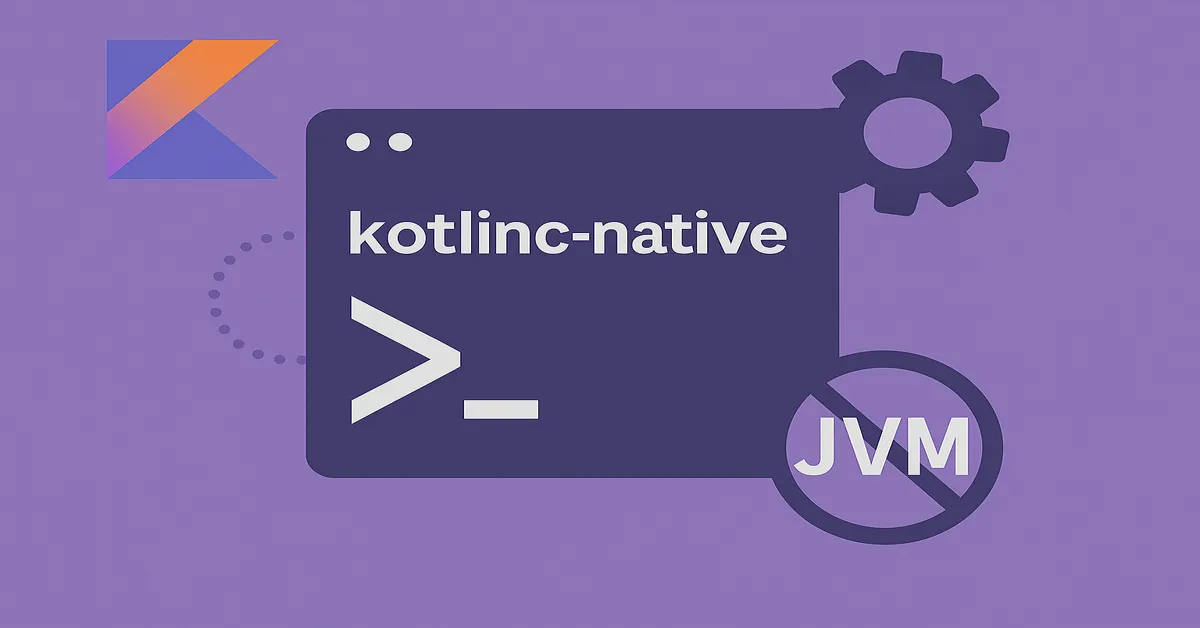In a software era increasingly focused on efficiency, portability, and performance, developers are reexamining the weight of traditional platforms. Among the most frequently questioned assumptions is the necessity of the Java Virtual Machine (JVM), especially for command-line tools and small utility applications. While the JVM offers flexibility and cross-platform capabilities, it often comes with cold-start delays, memory overhead, and deployment complexity – Kotlin Native.
For Kotlin developers, this raises an intriguing possibility: What if you could write a CLI (Command-Line Interface) tool in Kotlin—without ever touching the JVM?
Enter Kotlin/Native, JetBrains’ bold initiative that compiles Kotlin’s code to native binaries, unlocking true platform-level integration and runtime independence. With Kotlin/Native, developers can now build fast, portable CLI tools in a language they already know, deploy them as standalone executables, and run them instantly—on Linux, macOS, or Windows—no JVM runtime required.
This article provides a comprehensive, real-world guide to using Kotlin/Native’s for building CLI tools: from project setup and architecture to packaging, performance tuning, and deployment.
What Is Kotlin/Native?
Kotlin/Native is a Kotlin compiler backend that targets native’s binaries using LLVM. Instead of generating Java bytecode, it compiles directly to machine code. It supports platforms like:
- macOS (x64, ARM)
- Linux
- Windows (via MinGW)
- iOS and embedded systems
Unlike Kotlin/JVM, Kotlin/Native’s apps do not require a virtual machine or garbage collector. They are self-contained binaries with deterministic memory behavior, suitable for performance-critical, portable, or lightweight tasks.
Kotlin/Native is particularly useful for:
- CLI tools
- Embedded software
- Desktop utilities
- Interop with C/Objective-C
- Scripting where startup time matters
Why Build a CLI Tool Without the JVM?
Building CLI tools without the JVM addresses several common pain points:
1. Cold Start Performance
JVM applications, even tiny ones, can take several seconds to launch due to JVM warmup. Native binaries launch instantly.
2. Distribution Simplicity
Native binaries can be distributed as standalone files—no JVM installation or environment configuration required.
3. Memory Efficiency
Native binaries use less memory and have predictable usage patterns, especially useful for constrained environments or batch scripts.
4. System Integration
Need to call C libraries or use low-level system calls? Kotlin/Native enables this through direct interop without JNI complexity.
Setting Up a Kotlin/Native Project
JetBrains provides project templates and Gradle support for Kotlin/Native’s, but you can also start from scratch.
1. Prerequisites
- Kotlin 1.9+ (for latest Native support)
- IntelliJ IDEA (Ultimate or Community)
- LLVM toolchain (preinstalled on macOS; install on Linux/Windows)
- Gradle 8+
2. Creating a Native Project
Using IntelliJ:
- Create a Kotlin/Native project using the “Kotlin Native’s | Console Application” template.
Or manually using Gradle:
kotlinCopyEditplugins {
kotlin("multiplatform") version "1.9.0"
}
kotlin {
linuxX64("native") {
binaries {
executable {
entryPoint = "main"
}
}
}
sourceSets {
val nativeMain by getting {
dependencies {
// No JVM dependencies here
}
}
}
}
This configuration builds an executable for Linux x64. Change the target to macosX64 or mingwX64 for macOS or Windows.
3. The Entry Point
Create src/nativeMain/kotlin/Main.kt:
kotlinCopyEditfun main() {
println("Hello from Kotlin/Native!")
}
Build and run:
bashCopyEdit./gradlew linkNativeDebugExecutableNative
./build/bin/native/debugExecutable/yourapp.kexe
You’ve just run your first Kotlin app without the JVM.
Building a Real CLI Tool: Word Frequency Counter
Let’s walk through building a practical CLI tool: a word frequency analyzer that reads a file and prints the top N most frequent words.
1. Parsing Command-Line Arguments
Kotlin/Native’s doesn’t include built-in CLI parsers, but you can write a simple one:
kotlinCopyEditdata class Config(val filePath: String, val topN: Int)
fun parseArgs(args: Array<String>): Config {
if (args.size < 2) {
println("Usage: ./wordcount <file> <topN>")
exitProcess(1)
}
val filePath = args[0]
val topN = args[1].toIntOrNull() ?: run {
println("Invalid number: ${args[1]}")
exitProcess(1)
}
return Config(filePath, topN)
}
2. Reading Files in Kotlin/Native
Native Kotlin’s doesn’t use java.io.*. Instead, it offers:
kotlinCopyEditimport kotlinx.cinterop.*
import platform.posix.*
fun readFileLines(path: String): List<String> {
val file = fopen(path, "r") ?: throw IllegalArgumentException("Cannot open file: $path")
val lines = mutableListOf<String>()
try {
memScoped {
val buffer = allocArray<ByteVar>(1024)
while (fgets(buffer, 1024, file) != null) {
lines.add(buffer.toKString())
}
}
} finally {
fclose(file)
}
return lines
}
You can also use okio (from Square) if preferred and compatible.
3. Analyzing Word Frequencies
kotlinCopyEditfun countWords(lines: List<String>): Map<String, Int> {
val frequency = mutableMapOf<String, Int>()
lines.forEach { line ->
line.trim().split(Regex("\\W+")).forEach { word ->
if (word.isNotBlank()) {
val lower = word.lowercase()
frequency[lower] = frequency.getOrDefault(lower, 0) + 1
}
}
}
return frequency
}
4. Displaying Top N Results
kotlinCopyEditfun printTopWords(freq: Map<String, Int>, topN: Int) {
freq.entries
.sortedByDescending { it.value }
.take(topN)
.forEach { (word, count) ->
println("$word: $count")
}
}
5. Putting It All Together
kotlinCopyEditfun main(args: Array<String>) {
val config = parseArgs(args)
val lines = readFileLines(config.filePath)
val frequencies = countWords(lines)
printTopWords(frequencies, config.topN)
}
Build it:
bashCopyEdit./gradlew linkNativeReleaseExecutableNative
Your binary is now ready to distribute.
Packaging and Distribution
Kotlin/Native’s builds a .kexe executable by default.
For Linux/macOS:
bashCopyEditcp build/bin/native/releaseExecutable/wordcounter.kexe /usr/local/bin/wordcounter
chmod +x /usr/local/bin/wordcounter
For Windows, output is a .exe file.
These binaries are fully self-contained—no need to ship a JDK, runtime, or dependencies.
Cross-Platform Compilation
You can build for other targets using Gradle or Docker.
bashCopyEdit./gradlew linkMingwX64ReleaseExecutable
To compile for multiple platforms in CI/CD pipelines:
- Use GitHub Actions with matrix builds
- Use Docker images for cross-compilation
- Host prebuilt binaries on GitHub Releases
Interacting with C Libraries (Optional)
Kotlin/Native’s can interop directly with C code. You can:
- Include
.hheaders - Use
cinteroptool - Call native functions as Kotlin’s functions
This makes it ideal for performance-critical tools or those that need to use native system APIs.
Best Practices for Kotlin/Native CLI Development
✅ Keep Dependencies Minimal
Many JVM libraries aren’t available in Native. Stick to core Kotlin’s or Native-specific libraries.
✅ Use Build Profiles
Build in Debug mode for development (linkNativeDebugExecutableNative) and Release for production (linkNativeReleaseExecutableNative).
✅ Profile Memory Use
Use tools like Valgrind or LeakSanitizer to detect memory issues.
✅ Be Mindful of I/O
I/O APIs differ from JVM. Test file handling on each target OS to catch edge cases.
Limitations and Challenges
Kotlin/Native is evolving, but some caveats remain:
- Longer build times than JVM compilation.
- Limited library support compared to JVM.
- Memory management is manual (no GC); requires careful resource use.
- Debugging support is not as mature.
Still, for many CLI and utility tasks, these trade-offs are outweighed by the benefits.
Real-World Use Cases
🔧 DevOps Tools
Build cross-platform deploy tools, formatters, analyzers, and setup scripts in Kotlin Native’s and distribute them via CI/CD.
🔍 Static Analysis
Implement file scanning, log parsing, or code metrics tools that run without JVM startup lag.
🧩 Scripting for End-Users
Build consumer-friendly command-line tools that can be bundled into installers or embedded into apps.
Future of Kotlin/Native
JetBrains continues to invest in Kotlin/Native as part of Kotlin’s Multiplatform. As toolchains stabilize and interop matures, we can expect:
- Faster compilation times
- Better integration with Compose Multiplatform
- IDE debugging and profiler support
- Expansion to ARM-based systems (Raspberry Pi, M1 Macs)
For developers seeking JVM-free Kotlin, the future is bright.
Conclusion
Kotlin/Native opens the door to a world where Kotlin’s is no longer confined to JVM-heavy stacks. For CLI tools—where fast startup, small size, and broad compatibility are crucial—Kotlin/Native offers a compelling modern alternative to Go, Rust, and even C.
It allows developers to write expressive Kotlin’s code, compile it to native binaries, and ship software that runs anywhere—instantly, securely, and efficiently.
No JVM required. Just Kotlin, distilled to its simplest, fastest form.
Read:
How We Built a Scalable Kotlin App for Millions of Users
Kotlin and AI: Building an AI Chatbot Using Kotlin + OpenAI API
Kotlin Wasm (WebAssembly): Writing Web Apps in Kotlin Without JS
FAQs
1. What is Kotlin/Native, and how is it different from Kotlin/JVM?
Kotlin/Native compiles Kotlin code directly into native’s binaries using LLVM, allowing it to run without a Java Virtual Machine (JVM). In contrast, Kotlin/JVM compiles to Java bytecode and requires the JVM to execute. Kotlin/Native is ideal for lightweight tools, system-level programs, or platforms where the JVM is not available or practical.
2. Can I build cross-platform CLI tools with Kotlin/Native?
Yes. Kotlin/Native supports multiple platforms, including Linux, macOS, Windows, iOS, and more. You can compile your Kotlin’s code into platform-specific native binaries and distribute them as standalone executables. With Kotlin Multiplatform, you can even share logic across CLI, mobile, and desktop apps.
3. Does Kotlin/Native support standard I/O and file handling?
Yes. Kotlin/Native provides POSIX-like APIs for standard input/output, file reading, and memory management. While these differ slightly from JVM I/O APIs, they’re efficient and suitable for CLI utilities. Libraries like okio can also help with abstracted file I/O if needed.
4. Do Kotlin/Native CLI tools require any runtime or external dependencies?
No. Kotlin/Native generates self-contained native binaries, meaning your CLI tool will not require a JVM, runtime environment, or any external dependencies to run. You can simply distribute the compiled .exe (Windows) or .kexe (Linux/macOS) file.
5. Is Kotlin/Native stable and production-ready for CLI tools?
Yes, for many use cases. Kotlin/Native is stable and effective for building CLI tools, scripts, and lightweight native utilities. While there are still limitations—such as fewer libraries and longer compile times—it is production-capable, especially for tools that need instant startup, low memory usage, and JVM independence.











